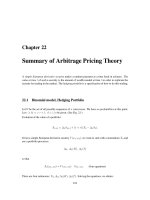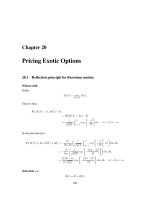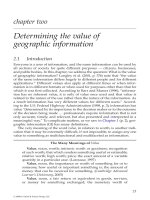Arbitrage Pricing
Bạn đang xem bản rút gọn của tài liệu. Xem và tải ngay bản đầy đủ của tài liệu tại đây (167.5 KB, 8 trang )
Chapter 3
Arbitrage Pricing
3.1 Binomial Pricing
Return to the binomial pricing model
Please see:
Cox, Ross and Rubinstein, J. Financial Economics, 7(1979), 229–263, and
Cox and Rubinstein (1985), Options Markets, Prentice-Hall.
Example 3.1 (Pricing a Call Option) Suppose
u =2;d =0:5;r = 25
(interest rate),
S
0
=50
. (In this
and all examples, the interest rate quoted is per unit time, and the stock prices
S
0
;S
1
;:::
are indexed by the
same time periods). We know that
S
1
! =
100
if
!
1
= H
25
if
!
1
= T
Find the value at time zero of a call option to buy one share of stock at time 1 for $50 (i.e. the strike price is
$50).
The value of the call at time 1 is
V
1
! =S
1
!,50
+
=
50
if
!
1
= H
0
if
!
1
= T
Suppose the option sells for $20 at time 0. Let us construct a portfolio:
1. Sell 3 options for $20 each. Cash outlay is
,$60:
2. Buy 2 shares of stock for $50 each. Cash outlay is $100.
3. Borrow $40. Cash outlay is
,$40:
59
60
This portfolio thus requires no initial investment. For this portfolio,the cash outlay at time 1 is:
!
1
= H !
1
= T
Pay off option
$150 $0
Sell stock
,$200 ,$50
Pay off debt
$50 $50
,,,, , ,,,,,
$0 $0
The arbitrage pricing theory (APT) value of the option at time 0 is
V
0
=20
.
Assumptions underlying APT:
Unlimited short selling of stock.
Unlimited borrowing.
No transaction costs.
Agent is a “small investor”, i.e., his/her trading does not move the market.
Important Observation: The APT value of the option does not depend on the probabilities of
H
and
T
.
3.2 General one-step APT
Suppose a derivative security pays off the amount
V
1
at time 1, where
V
1
is an
F
1
-measurable
random variable. (This measurability condition is important; this is why it does not make sense
to use some stock unrelated to the derivative security in valuing it, at least in the straightforward
method described below).
Sell the security for
V
0
at time 0. (
V
0
is to be determined later).
Buy
0
shares of stock at time 0. (
0
is also to be determined later)
Invest
V
0
,
0
S
0
in the money market, at risk-free interest rate
r
.(
V
0
,
0
S
0
might be
negative).
Then wealth at time 1 is
X
1
4
=
0
S
1
+1+rV
0
,
0
S
0
= 1 + rV
0
+
0
S
1
,1 + rS
0
:
We want to choose
V
0
and
0
so that
X
1
= V
1
regardless of whether the stock goes up or down.
CHAPTER 3. Arbitrage Pricing
61
The last condition above can be expressed by two equations (which is fortunate since there are two
unknowns):
1 + rV
0
+
0
S
1
H,1 + rS
0
=V
1
H
(2.1)
1 + rV
0
+
0
S
1
T,1 + rS
0
=V
1
T
(2.2)
Note that this is where we use the fact that the derivative security value
V
k
is a function of
S
k
,
i.e., when
S
k
is known for a given
!
,
V
k
is known (and therefore non-random) at that
!
as well.
Subtracting the second equation above from the first gives
0
=
V
1
H , V
1
T
S
1
H , S
1
T
:
(2.3)
Plug the formula (2.3) for
0
into (2.1):
1 + rV
0
= V
1
H ,
0
S
1
H , 1 + rS
0
= V
1
H ,
V
1
H , V
1
T
u , dS
0
u , 1 , rS
0
=
1
u , d
u , dV
1
H , V
1
H , V
1
T u , 1 , r
=
1+r ,d
u,d
V
1
H+
u, 1, r
u ,d
V
1
T:
We have already assumed
ud 0
. We now also assume
d 1+r u
(otherwise there would
be an arbitrage opportunity). Define
~p
4
=
1+r,d
u,d
; ~q
4
=
u,1,r
u,d
:
Then
~p 0
and
~q0
.Since
~p +~q =1
,wehave
0 ~p1
and
~q =1,~p
. Thus,
~p; ~q
are like
probabilities. We will return to this later. Thus the price of the call at time 0 is given by
V
0
=
1
1+ r
~pV
1
H+ ~qV
1
T :
(2.4)
3.3 Risk-Neutral Probability Measure
Let
be the set of possible outcomes from
n
coin tosses. Construct a probability measure
f
IP
on
by the formula
f
IP !
1
;!
2
;::: ;!
n
4
=~p
fj;!
j
=Hg
~q
fj;!
j
=Tg
f
IP
is called the risk-neutral probabilitymeasure. We denote by
f
IE
the expectation under
f
IP
. Equa-
tion 2.4 says
V
0
=
f
IE
1
1+r
V
1
:
62
Theorem 3.11 Under
f
IP
, the discountedstock price process
f1 + r
,k
S
k
; F
k
g
n
k=0
is a martingale.
Proof:
f
IE 1 + r
,k+1
S
k+1
jF
k
= 1 + r
,k+1
~pu +~qdS
k
= 1 + r
,k+1
u1 + r , d
u , d
+
du , 1 , r
u , d
S
k
= 1 + r
,k+1
u + ur , ud + du , d , dr
u , d
S
k
= 1 + r
,k+1
u , d1 + r
u , d
S
k
= 1 + r
,k
S
k
:
3.3.1 Portfolio Process
The portfolio process is
=
0
;
1
;::: ;
n,1
,where
k
is the number of shares of stock held between times
k
and
k +1
.
Each
k
is
F
k
-measurable. (No insider trading).
3.3.2 Self-financing Value of a Portfolio Process
Start with nonrandom initial wealth
X
0
, which need not be 0.
Define recursively
X
k+1
=
k
S
k+1
+1+rX
k
,
k
S
k
(3.1)
= 1 + rX
k
+
k
S
k+1
, 1 + rS
k
:
(3.2)
Then each
X
k
is
F
k
-measurable.
Theorem 3.12 Under
f
IP
, the discountedself-financingportfolioprocessvalue
f1 + r
,k
X
k
; F
k
g
n
k=0
is a martingale.
Proof: We have
1 + r
,k+1
X
k+1
=1+r
,k
X
k
+
k
1 + r
,k+1
S
k+1
, 1 + r
,k
S
k
:
CHAPTER 3. Arbitrage Pricing
63
Therefore,
f
IE 1 + r
,k+1
X
k+1
jF
k
=
f
IE 1 + r
,k
X
k
jF
k
+
f
IE 1 + r
,k+1
k
S
k+1
jF
k
,
f
IE 1 + r
,k
k
S
k
jF
k
= 1 + r
,k
X
k
(requirement (b) of conditional exp.)
+
k
f
IE 1 + r
,k+1
S
k+1
jF
k
(taking out what is known)
,1 + r
,k
k
S
k
(property (b))
= 1 + r
,k
X
k
(Theorem 3.11)
3.4 Simple European Derivative Securities
Definition 3.1 () A simpleEuropeanderivativesecuritywith expirationtime
m
is an
F
m
-measurable
random variable
V
m
.(Here,
m
is less than or equal to
n
, the number of periods/coin-tosses in the
model).
Definition 3.2 () A simple European derivative security
V
m
is said to be hedgeable if there exists
a constant
X
0
and a portfolio process
=
0
;::: ;
m,1
such that the self-financing value
process
X
0
;X
1
;::: ;X
m
given by (3.2) satisfies
X
m
! =V
m
!; 8! 2:
In this case, for
k =0;1;::: ;m
, we call
X
k
the APT value at time
k
of
V
m
.
Theorem 4.13 (Corollary to Theorem 3.12) If a simple European security
V
m
is hedgeable, then
for each
k =0;1;::: ;m
, the APT value at time
k
of
V
m
is
V
k
4
=1+r
k
f
IE1 + r
,m
V
m
jF
k
:
(4.1)
Proof: We first observe that if
fM
k
; F
k
; k =0;1;::: ;mg
is a martingale, i.e., satisfies the
martingale property
f
IE M
k+1
jF
k
=M
k
for each
k =0;1;::: ;m, 1
,thenwealsohave
f
IE M
m
jF
k
=M
k
;k =0;1;::: ;m, 1:
(4.2)
When
k = m , 1
, the equation (4.2) follows directly from the martingale property. For
k = m , 2
,
we use the tower property to write
f
IE M
m
jF
m,2
=
f
IE
f
IE M
m
jF
m,1
jF
m,2
=
f
IE M
m,1
jF
m,2
= M
m,2
:









